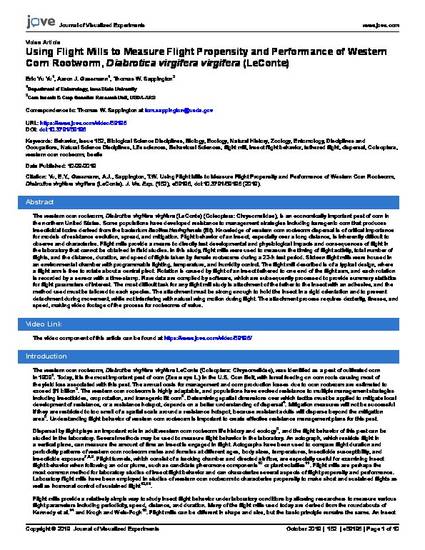
The western corn rootworm, Diabrotica virgifera virgifera (LeConte) (Coleoptera: Chrysomelidae), is an economically important pest of corn in the northern United States. Some populations have developed resistance to management strategies including transgenic corn that produces insecticidal toxins derived from the bacterium Bacillus thuringiensis (Bt). Knowledge of western corn rootworm dispersal is of critical importance for models of resistance evolution, spread, and mitigation. Flight behavior of an insect, especially over a long distance, is inherently difficult to observe and characterize. Flight mills provide a means to directly test developmental and physiological impacts and consequences of flight in the laboratory that cannot be obtained in field studies. In this study, flight mills were used to measure the timing of flight activity, total number of flights, and the distance, duration, and speed of flights taken by female rootworms during a 22-h test period. Sixteen flight mills were housed in an environmental chamber with programmable lighting, temperature, and humidity control. The flight mill described is of a typical design, where a flight arm is free to rotate about a central pivot. Rotation is caused by flight of an insect tethered to one end of the flight arm, and each rotation is recorded by a sensor with a time-stamp. Raw data are compiled by software, which are subsequently processed to provide summary statistics for flight parameters of interest. The most difficult task for any flight mill study is attachment of the tether to the insect with an adhesive, and the method used must be tailored to each species. The attachment must be strong enough to hold the insect in a rigid orientation and to prevent detachment during movement, while not interfering with natural wing motion during flight. The attachment process requires dexterity, finesse, and speed, making video footage of the process for rootworms of value.
Available at: http://works.bepress.com/aaron_gassmann/86/

This article is published as Yu, E. Y., Gassmann, A. J., Sappington, T. W. Using Flight Mills to Measure Flight Propensity and Performance of Western Corn Rootworm, Diabrotica virgifera virgifera (LeConte). J. Vis. Exp. (152), e59196, doi: 10.3791/59196.